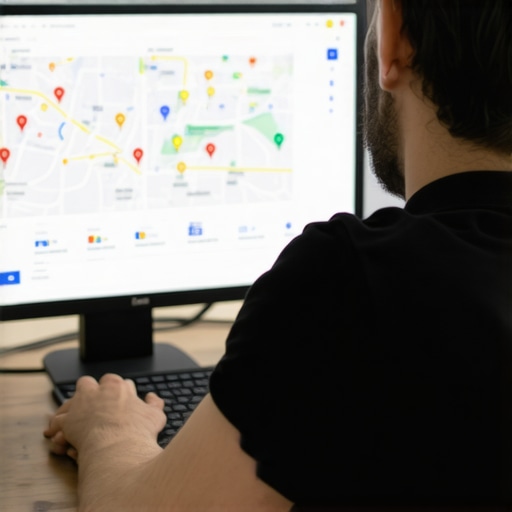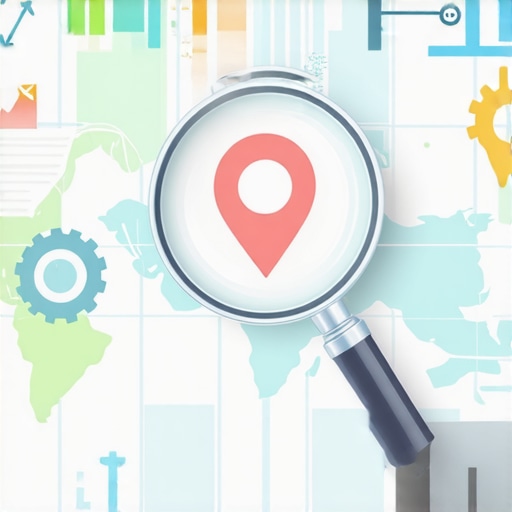My Journey to Dominating Google Maps Rankings
When I first started my small business, I struggled to get noticed locally. Despite having a great service, my Google Maps listing was buried under competitors. I remember feeling frustrated, wondering how some businesses always seemed to appear at the top of local searches. That was until I decided to dive deep into Google My Business (GMB) optimization and local SEO strategies.
Through trial, error, and a lot of research, I discovered that boosting Google Maps rankings isn’t magic — it’s a mix of proven techniques and consistent effort. I started focusing on optimizing my GMB profile, gathering genuine reviews, and ensuring my NAP (Name, Address, Phone Number) consistency across directories. My first noticeable jump in rankings came after I implemented some of the tips I found in authoritative sources like this comprehensive guide.
What Are the Secrets to Climbing Google Maps Rankings?
One of the most impactful steps I took was ensuring my profile was fully optimized. That meant accurate categories, high-quality photos, and a compelling business description. I also learned that reviews play a pivotal role — positive reviews not only build trust but also influence rankings. Encouraging satisfied customers to leave reviews, without crossing ethical lines, made a big difference.
Another key element was local keyword integration. I included relevant terms naturally in my business description and posts. For example, if I ran a bakery in Brooklyn, I made sure to include phrases like “best Brooklyn bakery” or “artisan bread Brooklyn.” This helped Google associate my listing with local search queries, improving my visibility.
How Can I Keep Up With Changing Google Maps Algorithms?
This is a question I often ask myself. Google’s algorithm is always evolving, and staying ahead requires consistent learning. I regularly read updates from sources like GMB algorithm insights and adapt my strategies accordingly. Engaging with local SEO communities and attending webinars also keeps me informed about the latest trends.
If you’re serious about boosting your Google Maps ranking, I highly recommend exploring dedicated support services. They can offer tailored advice and help you navigate the complexities of local SEO with confidence. For a deeper dive into effective strategies, check out this resource.
Finally, don’t forget that authenticity matters. Google values genuine engagement and reviews. So, focus on providing excellent service, ask for feedback, and stay active on your profile. Over time, these efforts will pay off, and your business will climb the Google Maps ranks.
If you’ve tried any of these tips or have your own success stories, I’d love to hear from you! Drop a comment below or share your experiences. Remember, consistent effort and smart optimization are the keys to local search success.
Harnessing the Power of Local Citations for Enhanced Visibility
One often overlooked yet powerful tactic in elevating your Google Maps ranking is building consistent and authoritative local citations. These citations, which are mentions of your business name, address, and phone number (NAP) across various online directories, significantly influence Google’s trust in your business’s legitimacy and relevance. Ensuring your NAP details are uniform across platforms like Yelp, Bing Places, and industry-specific directories can give your profile a substantial boost. For in-depth guidance, explore this comprehensive guide.
Leveraging Google My Business Posts for Engagement and Rankings
Regularly updating your GMB profile with fresh posts can signal activity to Google, which favors active listings. Use these posts to share promotions, events, or behind-the-scenes insights. Incorporate relevant local keywords naturally within your posts to enhance local relevance. This ongoing engagement can improve your visibility in local search results and attract more nearby customers. Remember, consistency is key—schedule weekly updates to keep your profile lively and relevant. For strategies on optimizing your posts, visit this resource.
What Are the Nuances of Google’s Local Algorithm in 2024?
Understanding Google’s evolving local algorithm is crucial for sustained success. Unlike traditional SEO, local algorithms weigh factors like proximity, relevance, and prominence. Advances in AI and machine learning mean Google increasingly personalizes results based on user intent and behavior. For instance, a user searching for “best coffee shop” near them might see different results based on their previous interactions, reviews, and even time of day. Staying ahead requires monitoring algorithm updates through trusted sources such as GMB algorithm insights, and adapting your strategies accordingly. Incorporate local keywords, maintain high-quality reviews, and ensure your profile’s completeness to stay competitive.

How Can Businesses Sustain Long-Term Google Maps Success?
This is a question I often ponder as I see many businesses stumble after initial gains. The key lies in maintaining a holistic approach that combines on-page optimizations, reputation management, and active engagement. Regularly solicit reviews, respond to customer feedback promptly, and update your profile with current photos and offers. Additionally, leveraging local backlinks from reputable sites can reinforce your authority. For tailored advice, consider consulting specialized services like advanced support tactics, which can help you stay aligned with the latest algorithm changes and industry best practices.
Finally, keep an eye on your analytics. Google My Business Insights provides valuable data about customer interactions and search trends. Analyzing this information can reveal new opportunities for optimization, such as emerging local keywords or service areas to target. The ongoing process of refinement and engagement is what truly sustains a dominant presence on Google Maps.
If you’ve experimented with any of these advanced techniques or discovered your own secrets, I encourage you to share your insights below. Your experiences can help others navigate the complex world of local SEO and Google Maps ranking strategies. Remember, continuous learning and adaptation are the hallmarks of long-term success in local search optimization.
Unlocking the Nuances of Google’s Local Algorithm in 2024
Reflecting on my journey, I realize that understanding Google’s local algorithm requires more than just surface-level strategies; it demands a deep dive into its evolving nature. In 2024, Google’s algorithm continues to prioritize user intent, proximity, and even personalized search results. I’ve found that staying ahead involves not only following official updates but also analyzing competitors’ tactics and leveraging advanced tools for insights. For example, tools like BrightLocal or Whitespark have become indispensable for tracking local rankings and citation consistency, which are crucial for maintaining a competitive edge. As Google’s AI-driven algorithms become more sophisticated, businesses must adopt a mindset of continuous adaptation, testing new approaches, and refining their local SEO tactics.
How Can Businesses Sustain Long-Term Google Maps Success?
Sustaining long-term success is arguably more challenging than achieving initial rankings. My personal approach combines regular review solicitation, active engagement with customers, and ongoing profile optimization. I’ve learned that responding to reviews promptly and authentically fosters trust and signals to Google that your business is active and customer-focused. Additionally, I’ve experimented with local backlinks—getting mentions from community websites, local news outlets, and industry blogs—which reinforce my authority and relevance. This holistic view, blending reputation management with technical SEO and local engagement, has helped me maintain high rankings despite algorithm updates. I encourage others to view their Google My Business profile as a living asset—one that requires ongoing attention, creativity, and genuine human interaction to thrive over time.
What Are the Hidden Challenges of Local SEO and How Can I Overcome Them?
One challenge I faced was managing inconsistent citation data across directories, which can confuse Google’s trust signals. To overcome this, I dedicated time to auditing all my citations, ensuring NAP consistency, and using tools like Moz Local to identify discrepancies. Another subtle challenge is avoiding review spam or fake reviews while encouraging genuine feedback. I found that building a loyal customer base that feels valued naturally leads to authentic reviews, which are far more impactful and sustainable. Additionally, staying compliant with Google’s guidelines is critical; violating policies can lead to penalties or ranking drops. Staying informed through authoritative sources like this guide has helped me navigate these issues effectively. Ultimately, the key lies in transparency, authenticity, and meticulous data management—principles that have served me well in my local SEO endeavors.
If you’re navigating similar challenges or have insights to share, I invite you to comment below. Sharing real-world successes and struggles helps us all refine our strategies and grow stronger in our local search efforts. Remember, the landscape is always shifting, but with continuous learning and genuine engagement, your business can stay atop the local rankings and build lasting relationships with your community.
Deciphering Google’s Evolving Local Algorithms for Long-Term Success
In my ongoing exploration of local SEO, I’ve come to realize that understanding Google’s complex and ever-changing algorithms requires a blend of data-driven analysis and intuitive adaptation. In 2024, Google’s local algorithm emphasizes not only proximity, relevance, and prominence but also personalized search behaviors and AI-driven contextual signals. To stay ahead, I utilize advanced tools like BrightLocal and Whitespark, which enable me to monitor fluctuations in ranking patterns and citation consistency, providing actionable insights that inform my strategy. These insights are crucial, especially as Google’s machine learning models increasingly prioritize user engagement metrics and behavioral signals, which are subtle yet powerful indicators of local relevance.
Moreover, I’ve found that integrating structured data markup—specifically schema.org LocalBusiness structured data—can significantly enhance how Google interprets my business information, leading to improved visibility and ranking stability. Implementing schema helps Google better understand my offerings, services, and geographic relevance, especially in competitive markets. As detailed by Moz’s recent research, leveraging structured data can be a game-changer for local SEO, especially when combined with consistent citation management and review optimization.
How Do I Maintain a Competitive Edge Amid Algorithmic Shifts?
This ongoing challenge demands a proactive approach. I regularly audit my citations, reviews, and profile completeness, ensuring alignment with Google’s evolving guidelines. Equally important is fostering genuine customer engagement—promptly responding to reviews and encouraging authentic feedback. I also invest in local backlink building from reputable community sites and industry partners, which reinforces my business’s authority and relevance. These efforts create a resilient SEO ecosystem that can withstand algorithm updates, ensuring sustained visibility.
For those serious about long-term dominance, I recommend consulting specialized services like advanced support tactics, which offer tailored strategies to adapt to the latest algorithmic nuances and industry best practices. Remember, consistent engagement, strategic optimization, and data-informed adjustments are your best allies in navigating the dynamic landscape of local SEO.
Finally, I urge fellow entrepreneurs and marketers to view their Google My Business profiles as dynamic assets—living entities that require ongoing nurturing. Keep testing new approaches, analyzing performance metrics, and refining your tactics. Over time, these efforts will not only elevate your rankings but also deepen your connection with your local community, fostering loyalty and trust that transcend mere search engine rankings.
Things I Wish I Knew Earlier (or You Might Find Surprising)
The Power of Genuine Reviews
One thing I underestimated at first was how much authentic customer reviews could influence my Google Maps ranking. I used to think that optimizing my profile was enough, but I soon realized that genuine, positive feedback from real customers built trust and boosted my visibility. Encouraging honest reviews without crossing ethical lines became a game-changer for me.
The Impact of Consistent NAP Data
Consistency in my business name, address, and phone number across all directories was something I overlooked initially. After fixing discrepancies, I saw a notable improvement in my local rankings. It turns out that Google trusts consistent citations more, making this a simple yet powerful tactic I wish I had prioritized sooner.
Local Keyword Integration Matters More Than I Thought
Integrating local keywords naturally into my descriptions and posts helped Google associate my listing with relevant searches. I learned that stuffing keywords doesn’t work—authentic, relevant phrases like “Brooklyn bakery” made my profile more relevant and visible in local searches.
Active Engagement Keeps You Ahead
Responding promptly to reviews and updating my profile regularly kept my listing active. Google favors active profiles, and this ongoing engagement has helped me maintain and improve my rankings over time. It’s a continuous process that I now see as vital.
Resources I’ve Come to Trust Over Time
- BrightLocal: This tool has been indispensable for tracking local rankings and citation consistency. I recommend it to anyone serious about local SEO.
- Whitespark: Their local SEO tools and blog are gold mines for strategies and insights that keep me updated with the latest trends.
- Google’s Official Guidelines: Always trust the source directly from Google. Their updates and best practices have helped me avoid pitfalls and stay compliant.
- Moz Local: Great for auditing citations and fixing inconsistencies, which is crucial for maintaining a strong local presence.
Parting Thoughts from My Perspective
Looking back, mastering Google Maps ranking isn’t about shortcuts but consistent, authentic effort. The key is understanding that Google values genuine engagement, accurate information, and active profiles. If you show up regularly, provide value, and stay authentic, your business can climb the local ranks just like mine did. Remember, the landscape keeps changing, so stay curious, keep learning, and don’t be afraid to experiment. If this resonates with you, I’d love to hear your thoughts or your own experiences. Share it with someone who might find it helpful, and let’s keep the conversation going!

